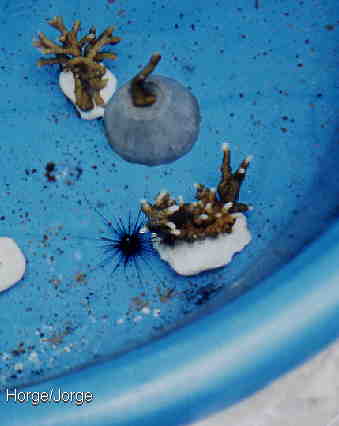| HÖRGE's Coral Reef Page |
| Reef Ecology |
| Ligpo Reef |
| Tank System |
| Collecting |
| Anchoring |
| Coral Care |
| Gallery |
| e-mail me |
| Home |
d
fbn
| The Art of Raising Corals |
|
| Care and Maintenance | ||
| Your coral frags require
five basic things to grow: Good Saltwater Quality Good Saltwater Circulation Proper Nutrition Stable Anchorage Protection from Encroachment/Damage Water is kept
"clean" of organic pollutants by the
protein skimmer and by the bacteria and algae in
and on the live rock and tank surfaces. Proper nutrition for hermatypic corals means adequate lighting to allow symbiotic 'zooxanthellae' (photosynthetic dinoflagellates) in them to produce starches and sugars for the coral. Thus you need to check against obstructions to light, whether they be dust, fallen leaves, pizza crusts or whatnot. Larger-polyped corals can be fed. This is very important with ahermatypic corals, which host no symbiotic algae. Anyway, this website focuses on small-polyped branching corals. |
You've already provided
stable anchorage by mounting the frag onto its
base. But you should still refrain from
frequently relocating the mounted frag. You will
protect the mounted frags from neighboring coral
(particularly coral of a different species).
Corals can and will wage war on another to
compete for space. You will also ensure that
algal growth does not choke coral access to
sunlight and anchoring substrate. Herbivores like
the small Diadema sp. urchin pictured
above are a great help... while they're small. Hitchhiking creatures in the live rock can also find their way into the basins and cause harm to your coral. Small anemones of the genus Aiptasia are hardy little pests that spread like crazy and can sting corals. Interestingly, Diadema urchins can eat them along with the algae. Protein skimmers
need to have clean columns in order to work
properly. Airstones need to be replaced once the
bubbles they produce are no longer fine in size.
The airpump's diaphragm may need replacing once a
year. Observe
your corals regularly! |
| Culling Coral |
| You will need to give a little coral
away within a year and a half of setting up, if
you've done everything right and have chosen
branching corals similar to those described in
this discussion. You should always leave 'parent colonies' -mounted specimens of sufficient size and branchiness as to be a good source of future frags. Fragmenting is often necessary to save a colony. Branching coral can outgrow its base, and branches left alone for too long can become too robust to frag easily. |
I have found that regularly
harvesting branches from a horizontally-mounted
'parent' is not only sustainable, but keeps the
'parent' from growing too big and taking up too
much space. Don't get the wrong idea: my parent colonies are SMALL, as in: less than fist size. Given the species of coral involved and the size of the grow-out basins, I feel that limiting them to that size makes for a situation that remains controllable. |
|
